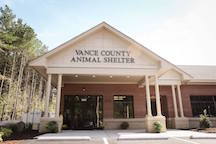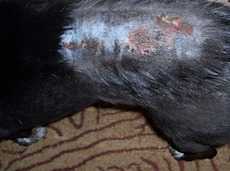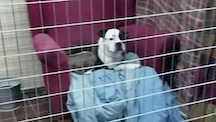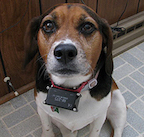Animal Officer Sings To Dogs
Chad Olds, Animal Control Officer Vance County, North Carolina
 Vance County North Carolina Animal Control Officer Chad Olds discovered a new use for his incredible singing skills. He's able to quiet the barking a several dozen dogs by playing guitar and singing to them. The shelter videotaped one of his sessions. The video went viral and adoptions increased.
Vance County North Carolina Animal Control Officer Chad Olds discovered a new use for his incredible singing skills. He's able to quiet the barking a several dozen dogs by playing guitar and singing to them. The shelter videotaped one of his sessions. The video went viral and adoptions increased.
As a child, Chad's father had polio so he didn't reach his sons sports, as he couldn't walk. However, he did teach them music, which has been a part of Chad's life ever since. At 15-years-of age, Chad hit the road singing and playing music and stayed out there for many, many years. He opened for a lot of big bands and even played at the Ryman Auditorium.
Now, Chad is an Animal Control Officer. Part of his day is coming in and taking care of the animals in the morning. In the afternoon, he goes out and does calls. These calls can include cruelty investigations, dealing with stray dogs and even setting traps. In the evening, he comes back and feeds and medicates the animals. This allows him to spend a lot of time with the animals.
Putting on a concert, so to speak, for the animals happened on accident. Chad was just playing around on his lunch break and his lieutenant chief said, "I wonder what would happen if we sing to the dogs?" Chad was ready and willing to give it a try. When Chad started singing, he said it was amazing. The animals just stopped barking and everybody just started listening. That afternoon, they even decided to film it. Chad was skeptical that it would work a second time, because it was almost feeding time and the animals are normally really loud at that time. But sure enough, he received the same reaction.
Since then, Chad's been spending many of his own hours off the clock with the animals, just practicing his singing and playing. He thinks he's probably singing to them 20 hours a week. He says its funny, because now that the animals have gotten so used to it, a lot of them just sleep through it. Chad says it really helps the animals by relaxing them. He tells us that the longer they can keep the animals healthy, the better chance they have to find a home and that's what they're after.
 It's no surprise that the video of Chad singing in the shelter went viral, encouraging people to visit the shelter and adopt. Chad explains that the first Saturday after all the news stories broke about it, they had seven adult dogs adopted in four hours, which was amazing. The puppies aren't really hard to get out the door, but the adult dogs are a little bit harder. Since then, they've had many people volunteer, some of them coming all the way from Raleigh. The shelter's numbers are also up and they're seeing comments from shelters all over the place that are trying this. Chad tells us of one in Atlanta with a young lady who started singing to the animals. She made the news in Atlanta, and Chad thinks it is wonderful that we can get people to change their view on shelters, because a lot of people have a bad image of shelters and don't even want to come in.
It's no surprise that the video of Chad singing in the shelter went viral, encouraging people to visit the shelter and adopt. Chad explains that the first Saturday after all the news stories broke about it, they had seven adult dogs adopted in four hours, which was amazing. The puppies aren't really hard to get out the door, but the adult dogs are a little bit harder. Since then, they've had many people volunteer, some of them coming all the way from Raleigh. The shelter's numbers are also up and they're seeing comments from shelters all over the place that are trying this. Chad tells us of one in Atlanta with a young lady who started singing to the animals. She made the news in Atlanta, and Chad thinks it is wonderful that we can get people to change their view on shelters, because a lot of people have a bad image of shelters and don't even want to come in.
Chad wants to make clear that he doesn't want this to be about him. He's glad that he can be a voice for them, but he wants the attention to be on the animals. A lot of people are saying that he's doing such a wonderful thing and he appreciates it. But he wants people to know that they don't have to be able to sing, they can still come out and volunteer their time and maybe even walk a dog. That's just as wonderful to them. So if they can get people to just come help out, they appreciate it. You can also visit your own local shelter who will appreciate it also.
Chad tells us that they actually have elementary school kids that come to the shelter on field trips and they read books in front of the cages. Thee kids receive almost the same reaction as when Chad sings. The dogs enjoy the children spending a little bit of time with them. You've got to imagine, they're in a small little cage for the most part of their day. Unfortunately, the shelter workers just don't have the manpower staff to actually walk every one of them every day as they're running calls too, so anytime anyone can come down and volunteer and do something, will keep their mind sane and give them a better chance to find a permanent home.
Normally, when people think of an animal control officer, it's probably not a positive image. They think the dogcatcher, but not in this case. Chad definitely goes above and beyond any kind of a terminology of a dogcatcher. Chad is hoping he can change that image all across the nation. If they can get people to look at shelters different, get people to come in, get hands on and get people involved to learn what it's all about, then they'll see its not as bad as what they thought and we can all do a lot of good.
If you haven't seen the video yet, you should check it out. Also look for another to come out next month. If you work in a shelter, you should think about adopting this particular process for not only bringing attention to the shelter, but also calming all the dogs down if you have someone that's a good musician.
Watch Video
Stress & Skin Issues
Dr. Tom Lewis, Founder of Dermatology for Animals
 Did you know that stress could be a factor in your pet's skin issues? Dr. Tom Lewis specializes in these sorts of health issues. As a proponent for the Fear Free movement, he says it's made a big difference in his practice.
Did you know that stress could be a factor in your pet's skin issues? Dr. Tom Lewis specializes in these sorts of health issues. As a proponent for the Fear Free movement, he says it's made a big difference in his practice.
You might not know it, but skin issues are the number one reason people take their pets to the vet. In fact, Dr. Tom Lewis explains that the number one problem dermatologists, and even general practitioners see, in both dogs and cats, is related to their skin. These issues consist primarily of allergies.
These allergies will cause not only the obvious rashes and itchy skin, but it can affect their ears as well. Surprisingly, in most dogs and cats that have reoccurring ear issues, the underlying cause is an allergy.
Some ear issues give off a smell like yeast. In fact, yeast and staph infections both certainly have the potential to make a lot of allergic, inflamed skin worse. However, typically these infections are like gas on the fire. It's important to deal with those infections, but it's even more important to deal with the underlying cause and get at the root, which usually is the allergy.
What can we do to reduce the incidence of dermatological problems in our animals? Dr. Lewis explains it all starts with a good exam. One of the challenges when an animal is nervous, anxious or stressed out, is that it is hard to look at their skin. Therefore, dermatologists schedule extra time for the appointment. This allows them to go slow throughout the process and build trust with the patient. If the patient's hiding behind the owners and struggling to get away, it's really hard to get a good look at their skin. Then from there, based on what they see physically, the clinician will come up with the list of concerns that they have and discuss with the owners some of the ways to treat whatever they're suspecting.
You might have seen food specifically labeled and marketed for healthy skin. Is this a marketing concept or is this something that you should buy? According to Dr. Lewis, it is a little bit of both. There's no question that diet is important to their skin and certainly a poor quality food with a low percentage of fatty acids is not going to treat their skin well. Having said that, many of the good quality brands have sufficient levels of fatty acids. Dr. Lewis sees value sometimes with prescription products when they're trying to diagnose and treat a food allergic animal. Unfortunately, many of the over-the-counter foods, even some of the big famous products, are not necessarily as pure as their labels claim. And with food allergies, they're worried very much about the particular individual ingredients. So in those cases, they'll use prescription products. But having said that, they see more value with basic supportive care of the skin. Dr. Lewis thinks you'll see as much, or more, value with frequent baths, for example, as you will with extra fatty acids, supplementation or specialty diets.
 Allergies are caused by many things, including environmental, food and parasites. But can stress cause skin problems? Dr. Lewis' experience is that stress is rarely the cause of the skin disease, but it sure can make it worse. If you have an allergic, itchy dog that's also anxious, he feels that that does make the overall sensation of that itch worse. Dr. Lewis tells us about another disease called acrylic granuloma, which is primarily induced by stress where a dog, especially an anxious dog, will repetitively lick an area on his body and create sometimes some just horribly deep infected lesions, which can be really a long-term battle to resolve.
Allergies are caused by many things, including environmental, food and parasites. But can stress cause skin problems? Dr. Lewis' experience is that stress is rarely the cause of the skin disease, but it sure can make it worse. If you have an allergic, itchy dog that's also anxious, he feels that that does make the overall sensation of that itch worse. Dr. Lewis tells us about another disease called acrylic granuloma, which is primarily induced by stress where a dog, especially an anxious dog, will repetitively lick an area on his body and create sometimes some just horribly deep infected lesions, which can be really a long-term battle to resolve.
Dr. Tom Lewis is also a Fear Free Certified Veterinarian and explains that this has helped him do a better job at what he does. One the reasons it helps, is that if his patient is struggling to get away, he just can't do a proper exam and the owner picks up on that experience. Unfortunately, so much of what they do in animal dermatology is really done by the owner. There's so much home care involved with successfully treating a dog or a cat with a skin problem. So if the owner's distracted, it just doesn't go as well. But in that fear free or reduced fear environment, the owner is more able to focus on the discussion they're having. The doctor is also able to do a better job of examining the patient and looking inside the ears, which again is such a commonplace for the allergy to manifest. Left untreated, this can lead to significant horrible pain and discomfort for patients. So getting all of that in a relaxed fear free session, which is not easy, is something they strive to do.
Visit Fear Free Happy Homes for tips on making your home fear free and to locate a Fear Free Veterinarian near you. Go to Fear Free Pets to become certified.
Listen and Explore the Fear Free Expert Series
It's Not Doggie Asthma - It's a Reverse Sneeze - Dr. Debbie
 What dog owner hasn't heard that frightening sound that dogs make - part cough, part sneeze and often described as a dog being unable to catch his breath. But it really isn't asthma, or some kind of bone stuck in your dog's throat - it's a reverse sneeze. So before you panic and run into the veterinary office on emergency, ensure you know what a reverse sneeze is.
What dog owner hasn't heard that frightening sound that dogs make - part cough, part sneeze and often described as a dog being unable to catch his breath. But it really isn't asthma, or some kind of bone stuck in your dog's throat - it's a reverse sneeze. So before you panic and run into the veterinary office on emergency, ensure you know what a reverse sneeze is.
Meet the Reverse Sneeze
A reverse sneeze is a respiratory sound in a category all its own. Also known as a pharyngeal gag reflex or backwards sneeze, the reverse sneeze is a commonly observed respiratory sound in dogs, and less commonly in cats. While a true sneeze occurs on the exhale, the reverse sneeze occurs as the dog inhales. The result is a reverberating snorting, wheezing, episodic sound that lasts for a few seconds to a minute or two. A reverse sneeze is a completely harmless sound and dogs do not suffer any immediate health threat from these episodes.
How can you tell it's a reverse sneeze?
There is no easy explanation of the sound - you just have to hear it and you'll recognize it. Click to see and hear an example of a dog's reverse sneeze episode.
Part of my enjoyment on the weekly national radio program, Animal Radio®, is describing the peculiar smells, sounds and essences of veterinary medicine with our listeners. On many an occasion when speaking to callers, I have re-created the sounds of reverse sneezing. I'm no Rich Little, but I do take pride in my impersonation of a canine reverse sneeze, which is admittedly better in person with the visuals to complement the throaty sound.
Characteristics of a dog displaying a reverse sneeze include:
 - Vibrational coughing/wheezing sound
- Vibrational coughing/wheezing sound
- Stiff, extended neck
- Facial grimace
- No discharge from nose
- Not followed by coughing or vomiting up material
- Not involving collapse episodes
- Animal is completely normal after event
What causes a reverse sneeze?
Some reverse sneeze episodes occur when a dog gets very excited or pulls against a leash. Brachycephalic breeds (short faced breeds) like Pugs and Boston terriers commonly display reverse sneezing due to their upper airway conformation.
Allergies, respiratory infections, nasal mites, inhaled foreign bodies and masses can also trigger reverse sneezing. Dogs with inflammatory conditions such as lymphoplasmacytic rhinitis can also display bouts of reverse sneezing. And sometimes reverse sneezing occurs in the wee hours of the night, while a dog is sleeping, for no apparent reason. In fact, many veterinarians receive panicked phone calls at 2am from pet owners, concerned of impending asthma attacks or respiratory arrest, only to have it turn out just to be a typical case of reverse sneezing.
What to Do?
There is no required treatment for a reverse sneeze episode. However, I recommend stroking a dog's throat while gently speaking to him in a calm manner until the episode subsides. Some advocate closing/pinching the nostrils off, which forces a dog to swallow and curtails the reverse sneeze episode. Whatever the approach, reverse sneezing episodes are over within minutes, so no emergency treatment is indicated. Antihistamines may be prescribed to minimize reverse sneezing episodes.
When to Worry?
If all of a sudden your dog is having repeated bouts of reverse sneezing, evaluation by your veterinarian is indicated. Consult with your veterinarian if your dog is reverse sneezing along with other symptoms such as facial rubbing, nasal bleeding, nasal discharge, coughing, or significant sneezing episodes.
Nasal mites are a common cause of reverse sneezing and may be noted after a recent boarding visit, especially if multiple dogs in a household are involved. Nasal mite treatment is easily pursued with anti-parasite injections of ivermectin (or in collie breeds - the alternative Milbemycin.) If reverse sneezing is excessive and prolonged, the nasal and pharyngeal areas should be evaluated by a veterinarian through rhinoscopy - a procedure performed under anesthesia in which the nasal passages and pharyngeal areas are visualized with an endoscope, a micro camera. This is how foreign objects and masses are typically identified. In other cases, further tests may be needed including a CT scan or with biopsy samples from sinus passages.
Final Thought
The good news is that most of reverse sneezing episodes are harmless, and do not indicate any serious illness. Arm yourself with information by learning what a reverse sneeze looks like and you may save yourself an unwanted emergency veterinary visit over this peculiar but non-life threatening occurrence.
Featured veterinarian known as "Dr. Debbie" on national pet radio program, Animal Radio. Ebook author of "Yorkshire Terriers: How to Be Your Dog's Best Friend"; "Pugs: How to Be Your Dog's Best Friend"; "Mini Schnauzers: How to Be Your Dog's Best Friend"; and "Shih Tzu: How to Be Your Dog's Best Friend." Dr. Debbie's books.
Visit Website
The Top Household Pet Poisons Found in Most Homes
Robert Semrow, Listomania
 March puts a spotlight on National Pet Poison Prevention. Every year we hear stories about the unintentional and devastating consequences of what many consider to be normal household items. So, take a minute or three today to identify if these items are in your home and make sure they are out of the reach of your beloved pets.
March puts a spotlight on National Pet Poison Prevention. Every year we hear stories about the unintentional and devastating consequences of what many consider to be normal household items. So, take a minute or three today to identify if these items are in your home and make sure they are out of the reach of your beloved pets.
Let's start with human and pet medications. It's a tragic truth that each year there are numerous horror stories about dogs, cats, ferrets and other quick and curious pets getting in to serious health situations by ingesting human and pet medications not meant for them. It should go without saying, but keep any and all medications out of the reach of your two-legged and four-legged children. Your pets can't read the tiny labels on the bottles, so they don't the kind of danger they are getting themselves in to.
Next are household cleaners. Just because it says all natural or green does not mean it is safe for your pets. If you are looking at the label for guidance, then you need to make sure it says "Pet Safe." There is a big difference between natural and environmentally safe and being pet safe. Your dogs, cats, birds and heck, any pet that can encounter the areas that you are cleaning can get the chemicals on their feet or other parts and when self-grooming they can ingest these chemicals, which can severely harm them.
 Rodenticides and pesticides can also present a major danger if ingested or if an intended victim is then chewed on or ingested by your pet. Also, be very vigilant of where you use traps and try to place them where a pet can't reach them and out of their regular areas. Again, sprays and chemicals that may be used should state that they are pet safe or they shouldn't be used around your pets.
Rodenticides and pesticides can also present a major danger if ingested or if an intended victim is then chewed on or ingested by your pet. Also, be very vigilant of where you use traps and try to place them where a pet can't reach them and out of their regular areas. Again, sprays and chemicals that may be used should state that they are pet safe or they shouldn't be used around your pets.
One more very common pet poison potential is from foods and alcohol that they have easy access to. Alcohol is universally dangerous for our pets. They do no know what it is and the unique smells may make it all that much more enticing to them. The same holds true for foods. Things like onions, candy, gum, grapes and raisins can have severe consequences for your pets and remember that we have an obesity epidemic and pet diabetes is also on the rise. So even foods that may ordinarily be safe, can present a danger to a pet that is obese or diabetic. Bottom line; make sure that there aren't any leftovers where your curious pet can get in to them.
Remember our pets trust us implicitly and they are prone to want to explore our worlds and do what we are doing. So if you are eating it or drinking it, they assume they can to. Until we develop a pet poison warning system that pets can understand, it's our responsibility to remove and reduce the household risks to our pets.
Share your ideas on how to remove and reduce household risks on our Animal Radio Facebook Page.
Visit Website
Animal Radio News - Lori Brooks
 Do You Speak "Baby" Talk To Your Pet?
Do You Speak "Baby" Talk To Your Pet?
It has long been known that talking to a baby improves bonding between parent and child. But, since so many pet parents view their pets as their own children, scientists were wondering does talking to your dog in the same way as you would a human infant have the same bonding effect? A recent study suggests it does. Researchers Alex Benjamin and Katie Slocombe, at the University of York in the United Kingdom, set out to investigate if so-called dog-speak improves bonding between pets and humans, and specifically, whether it is useful for the dogs to hear that high pitched baby talk. They found that adult dogs were more likely to want to interact and spend time with the speaker that used dog-directed speech with dog-related content, than they did with those that used adult-directed speech with no dog-related content. And, when they mixed-up the two types of speech and content, the dogs showed no preference for one speaker over the other. That suggests that adult dogs need to hear dog-relevant words spoken in a high-pitched emotional voice in order to find it relevant. The study was published in the journal Animal Cognition.
 Shelters Are Starting to Look Like Home
Shelters Are Starting to Look Like Home
An Illinois animal shelter is giving its dogs and cats the feeling of living in a real home by furnishing their kennels with old chairs donated by the public. These include old recliners and big comfy chairs, where an animal can sleep the day away comfortably. The Knox County Humane Society No Kill Shelter in Galesburg recently posted a video on its Facebook page and it went viral. The director of the shelter said the chair project was inspired by a pit bull named Buster, who has a tendency to hop onto any available chair, even if it's occupied by a staff member. The shelter has since begun collecting unwanted recliners and armchairs to furnish the kennels for the dogs, because having a chair in the kennel really helps give the dogs more of a home setting while they're held at a shelter. Workers at the shelter say it's especially helped one of the dogs, named Mickey, with his stress levels. Mickey has been in their shelter about a year and his human furniture seems to give him a greater sense of security. Since the video debuted online they've received a lot of chair donations allowing even the cats to lounge in luxury in the shelter's free-roaming cat room.
Would You Buy These Treats?
There's a new dog treat headed to store shelves and the name alone might make you NOT want to buy it, but I bet dogs will love it. A woman in Kansas has a patent pending on the new treat called, "Mickey And Moe's Butt Flavored Dog Treats."
 Shock Collars Banned in England
Shock Collars Banned in England
A ban on so-called pet "shock collars" will be enacted in England, under plans confirmed by the government. The shock collars, used to control pets, are usually controlled via a remote control and are already banned in Wales. Scotland has announced it is following England's lead with a ban of its own. This is similar to political battles that are happening in the US. Only in England, it's their political party called the Conservatives who are the animal rights supporters, while the country's Tory party would rather concentrate on their goal to bring back fox hunting and overturning a ban on ivory or elephant tusks. It's important to note that shock collars are often marketed as a harmless quick-fix solution or training aides, but animal experts say shock collars can easily cause more problems than they seek to fix.
 High Rate of Suicides Among Veterinarians
High Rate of Suicides Among Veterinarians
Santa Barbara, California is dealing with a crisis in its animal care community, which is a problem happening all over the country. The problem is the high rate of suicide among veterinarians. In fact, vets have the highest rate of suicide among all professional groups, four times higher than the national average. What has thrust this issue into the national spotlight is the recent suicides of two young female veterinarians in Santa Barbara. Each ran their own mobile practice giving at-home care to sick pets. Within months of each other, both women committed suicide, one late last year and the second one in early February. Their deaths shocked colleagues and clients, who said neither had shown any obvious signs of distress. But the deaths are reflective of a quiet crisis within the veterinary profession. Multiple studies in recent years have revealed disproportionately high rates of depression, anxiety and suicide among veterinarians in the United States. A Centers for Disease Control and Prevention survey of 10,000 practicing vets showed they displayed signs of serious mental illness and feelings of hopelessness and worthlessness, two to three times as often as the rest of the population. Similar statistics have been reported in Great Britain and Australia. Like their human-doctor counterparts, vets graduate from medical school with heavy student debt, but throughout their careers even the most accomplished will only earn about half of what human physicians make. Add that student debt to a mortgage, living expenses and mobile clinic van payments, and the financial burden can be overwhelming. Interestingly, many veterinarians talked about pressure from clients to perform services at no charge. Some out-of-line pet parents will say, "If you loved animals, you'd do it for free." The CDC survey results, based on answers from more than 10,000 practicing veterinarians, most (69-percent) of who are in small animal practice, revealed the following: 6.8-percent of males and 10.9-percent of females in the profession have serious psychological distress compared with 3.5-percent and 4.4-percent of U.S. male and female adults. 24.5-percent of males and 36.7-percent of females in veterinary medicine have experienced depressive episodes since veterinary school, which is about 1 and 1/2 times the prevalence in U.S. adults overall throughout their lifetime. 14.4-percent of males and 19.1-percent of females who are veterinarians have considered suicide since graduation. This is three times the U.S. national. This means that 1.1-percent of males and 1.4-percent of females in the veterinary profession have attempted suicide since veterinary school.
 Listen to the entire Podcast of this show (#955)
Listen to the entire Podcast of this show (#955)





